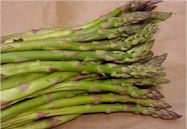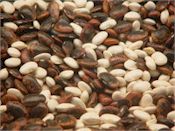|
|
|
 |
Globe
Artichoke
Whole
Globe artichokes are prepared for cooking by
removing all but 5-10 mm or so of the stem, and
cutting away about a quarter of each "leaf" with
scissors. This removes the thorns that interfere
with handling the leaves when eating. Then, the
artichoke is boiled or steamed until tender, about
|
|
15-45 minutes. If
boiling, salt can be added to the water, if desired.
The leaves are pulled off one by one from the tight rosette
dipped in some kind of sauce, perhaps butter &
lemon, mayonnaise or vinaigrette. The dipped soft
part is then pulled off with the teeth and all the
rest of the leaf discarded.
A knife is used
to remove the thistle (the immature florets); the
whole top layer of delicate feathery growth crowning
the heart. It is this central top of the stem that
supports the rosette that is sold cut up, pickled
and bottled as "artichoke hearts". |
|
 |
Asparagus
Keep fresh asparagus
clean, cold and covered. Trim the stem end about
1/4 inch and wash in warm water several times.
Pat dry and place in moisture-proof wrapping.
Refrigerate and use within 2 or 3 days for best
quality. |
|
To prepare, wash
under cool running water and trim an inch from
the stem end. Use a vegetable peeler to peel an
inch or two off the bottom end, if desired. The
peelings can be added to the cooking water
which, can be refrigerated and reused.
Asparagus can be eaten raw, steamed, boiled,
grilled, roasted or
incorporated into casseroles and salads. |
|
 |
Snap Bean
There
approximately 130 varieties of Snap beans. Varieties
specialized for use as green beans, selected for the
succulence and flavor of their pods, are the ones
usually grown in the home vegetable garden, and a
myriad of varieties exist. Pod color can be green,
golden, purple, red, or streaked. |
|
Shapes range from thin
fillet types to wide Romano types and more common
types in between. French Haricot verts (green beans)
are bred for flavorful pods. |
|
 |
Shell
Bean
The
pinto bean is named for its mottled skin, hence it
is a type of mottled bean.
It is the most common bean in the United States
and northwestern Mexico , and is most often eaten
whole in broth or mashed and refried. Either whole
or mashed, it is a common filling for burritos. The
young pods may
|
|
also be
used as green beans.
In the Southwest United States, the pinto bean is an
important symbol of regional identity, especially
among Mexican Americans. Along with the chili, it is
one of the official state vegetables of New Mexico
(under the name frijol). |
|
 |
Beet
Look for firm, small
to medium-size beets (up to 3 inches in
diameter). The outside may be rough, but should
be dry and tight.
Wash under running water to remove any trace of
dirt, dry on paper towel. Leave 1 inch of tops
on the beet when cooking or they will bleed and
you |
|
will loose their
beautiful red color. After a few minutes in
boiling water the skins will slip right off.
Cooked beets are tasty in cold salads with
vinaigrette, harvest beets
or most peoples favorite pickled beets. The beet
tops may also be cleaned and cooked like
spinach. |
|
 |
Broccoli
Select heads that have
tight and compact bud clusters with an even dark
color. The stems should be a lighter green than the
buds and easy to pierce with a fingernail. Avoid
stalks with yellowed or open bud clusters and stems
that are hard and dry. Broccoli can be stored in a
plastic bag in the refrigerator crisper. Before use,
clean by rinsing well in water. |
|
Use raw in salads,
stews, stir fry, or served alone with a
white or cheese sauce. |
|
 |
Brussels Sprout
Look for fresh, green
color with no sign of yellowing. The heads should be
dense and firm, the leaves unwilted. Smaller ones
are said to have the best flavor.
Soak in cold water and drain before using. Remove
any discolored or damaged outer leaves and trim stem
ends. Scoring the bottom lightly with an "X"
|
|
will promote even
cooking.
They may be steamed, boiled, microwaved or
stir-fried. Don't cook too long -
it's important to stop the cooking process before
you can detect a sulphurous smell.
Serve with a white or cheese sauce. |
|
 |
Cabbage
Purchase well-trimmed
heads, heavy for size and solid. Crisp leaves and
the stem end dry. Avoid broken, yellowed or heads
with wilted leaves.
Cole Slaw is the most popular use of cabbage,
however, it adds flavor when used in used is soups,
stews. Fried cabbage and cabbage
rolls are add a |
|
new variety to this
under used vegetable. The use of red cabbage will
brighten any salad. |
|
 |
Carrots
Long and short best
describes the carrots available. They should
have bright orange-gold color and be well
shaped. If the tops are attached, the leaves
should be bright green and fresh looking.
Carrots will keep in the refrigerator in a
plastic bag up to 10 days. Remove green tops
before storing as |
|
they will reduce the
carrots shelf life.
Carrots can be eaten raw, whole, chopped or
shaved into salads for color, and are also often
chopped and cooked in soups and stews. One can
also make carrot cake and
carrot pudding. The greens are edible as a leaf
vegetable, but are rarely eaten. |
|
 |
Cauliflower
Select clean, firm,
compact heads that are white or creamy white. Any
leaves that remain should be green and crisp. Avoid
heads with major spots, speckles, bruises, or loose,
open floret clusters. Some stores also sell packaged
florets that have been trimmed off the head, and
these, too, should be free of bruises or spots.
Refrigerate cauliflower
in the crisper, where it will keep for up to five
days If the head is unwrapped, store it in an open
or |
|
perforated plastic bag.
Keep the head stem-side up to prevent moisture from
collecting on top.
First, trim the cauliflower: Pull off any outer
leaves and cut off the protruding stem end close to
the head. If you find that the florets have started
to turn brown at the edges, trim off these areas. To
prepare florets, slice off the florets around the
inner core. Split any larger
florets in half and slice up the inner core pieces.
|
|
 |
Celery
As a salad
plant, celery, especially if at all "stringy", is
difficult to digest. Celery has 'negative calories', as
the effort to consume it burns more calories than it
contains.
Both blanched and green it
is stewed and used in soups, the seeds also being used
as a flavoring ingredient. Even after long immersion in
broth, the stalks remain somewhat crisp, and are useful
for adding texture to the soup.
Chopped, it is one of the three vegetables considered
the |
|
holy trinity of Louisiana Creole and Cajun
cuisine. It is also one of the three vegetables
(together with onions and carrots) that constitute the
French mirepoix, which is often used as a base
for sauces and soups. |
Artichoke - Celery
Collards - Onion
Parsnips - Turnips
|
|